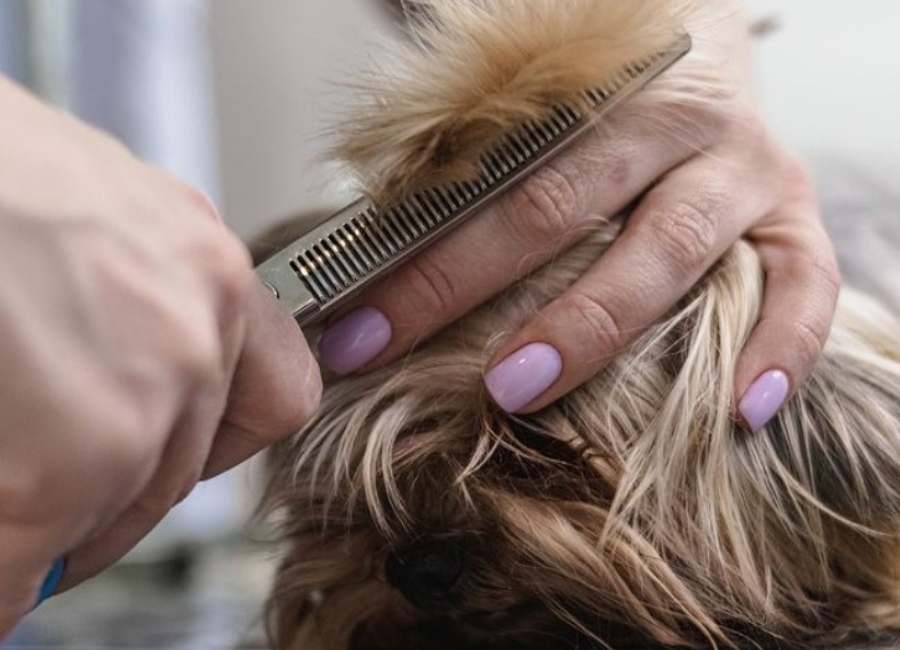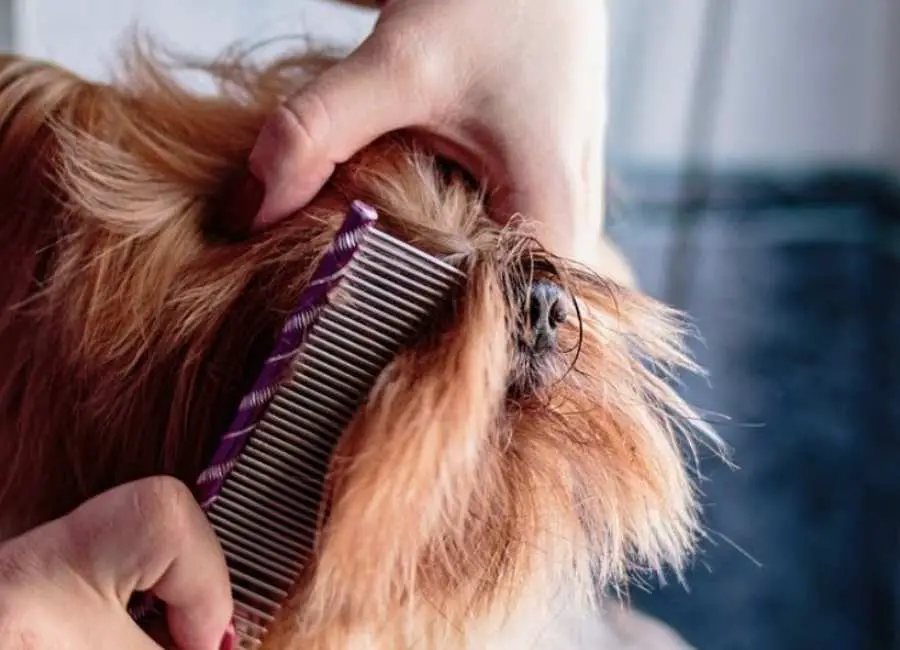14 Common Causes Of Excessive Shedding In Dogs

This post will address the most common causes of excessive shedding in dogs, so keep reading!
When it comes to our furry friends, we want nothing more than for them to be happy and healthy.
Unfortunately, sometimes even the best-cared-for dogs can experience problems with their health – one of which is excessive shedding.
There could be various reasons why your dog is shedding more than usual some of which can be beyond control.
Shedding In Dogs

Shedding is a natural process for dogs that helps to keep their coats healthy and clean.
While some dogs shed more than others, all dogs will shed at least some hair throughout their lives.
Although shedding is normal, it can be frustrating for pet parents who have to deal with the constant mess.
There are a few things that you can do to help minimize the shedding in your home. First, make sure that your dog is getting regular brushing.
This will help to remove loose hair from the coat before it has a chance to fall out on your furniture or floor.
Secondly, consider using a shedding shampoo or conditioner when you bathe your dog.
Causes Of Excessive Shedding In Dogs
Excessive shedding in dogs can because be a lot of things.
Here are some common causes of excessive shedding in dogs:
1. Seasonal shedding
As the season change, so does your dog’s coat. In the spring and summer, your dog will shed their winter coat in preparation for the warmer weather. This is perfectly normal and nothing to be concerned about.
2. Poor Diet
A poor diet can cause your dog to shed excessively. Dogs need a well-balanced diet that includes all the nutrients they need for healthy skin and fur.
If your dog isn’t getting enough of the right nutrients, it may start to shed excessively.
Nutritional deficiencies can also cause excessive shedding. If your dog isn’t getting enough of certain nutrients, such as proteins, they may start to shed more.
Additionally, nutritional deficiencies can cause other symptoms, such as weight loss, lethargy, and hair loss.
If you think your dog may be deficient in certain nutrients, talk to your veterinarian.
3. Allergies
Allergies are a common cause of excessive shedding in dogs. If your dog is allergic to something in its environment, such as pollen or dust, it may start to shed excessively.
Allergies can also be caused by certain foods or chemicals. If you think your dog may be allergic to something, speak to your veterinarian.
4. Excessive stress
Just like humans, dogs can also suffer from stress. If your dog is experiencing a lot of stress, it may start to shed excessively.
Stress can be caused by a number of things, such as a change in environment, a new pet or baby in the family, or even loud noises.
5. Hormonal Imbalance
A hormonal imbalance can cause your dog to shed excessively.
This is most common in female dogs who are not spayed but can also happen in male dogs.
If you think your dog may have a hormonal imbalance, speak to your veterinarian.
6. Lack of Grooming
If you’re not regularly grooming your dog, it may start to shed excessively.
Dogs need to be brushed and their coat needs to be kept clean and free of mats and tangles.
If you’re not sure how to groom your dog, speak to your veterinarian or a professional groomer.
7. Illness or Disease
Unfortunately, sometimes the cause of excessive shedding in dogs is an underlying illness or disease.
If your dog is suddenly shedding a lot more than usual, it’s important to take them to the vet to rule out any health problems.
8. Medications
Certain medications can cause dogs to shed excessive amounts of hair.
This includes, but is not limited to, antibiotics, pain medications, anti-anxiety medications, and sedatives.
While shedding may be a temporary side effect of taking these medications, it can also be a sign that your dog is in pain or experiencing anxiety.
If you notice your dog is shedding a lot, talk to your veterinarian about possible alternatives to the medication that is causing the problem.
In some cases, a different medication may work better or a different dosage may be required.
If your dog is taking any medications, speak to your veterinarian to see if this could be the cause of their excessive shedding.
9. Old Age
As dog age, they may start to shed more than usual. This is perfectly normal and nothing to be concerned about.
If your dog is shedding excessively, it’s important to speak to your veterinarian to rule out any health problems.
Once any underlying health problems have been ruled out, there are a number of things you can do to help reduce your dog’s shedding, such as changing their diet, increasing their grooming, and reducing their stress.
It’s that time of year again. The leaves are changing color, the air is getting crisp, and your dog is shedding like crazy.
While some shedding is normal, excessive shedding can be a sign of a health problem.
10. Anxiety
Anxiety can also cause your dog to shed excessively.
If your dog is anxious or stressed, it may start licking or chewing its fur, which can lead to hair loss.
Additionally, dogs who are anxious may pant excessively, which can also cause shedding.
If you think your dog may be anxious, talk to your veterinarian about possible solutions.
Learn more about separation anxiety in dogs.
11. Parasites
Parasites, such as fleas, ticks, and mites, can also cause excessive shedding in dogs.
If your dog has parasites, it may scratch its skin excessively, which can lead to hair loss.
Additionally, parasites can cause other symptoms, such as itching, redness, and hair loss.
If you think your dog may have parasites, talk to your veterinarian.
12. Skin infections
Skin infections, such as mange, can also cause excessive shedding.
If your dog has a skin infection, it may scratch its skin excessively, which can lead to hair loss.
Additionally, skin infections can cause other symptoms, such as itching, redness, and hair loss.
If you think your dog may have a skin infection, talk to your veterinarian.
13. Steroids
Steroids, such as those used to treat allergies, can also cause excessive shedding in dogs.
If your dog is taking steroids, it may start to shed more than usual.
Additionally, steroids can cause other side effects, such as weight gain, increased appetite, and panting.
If you think your dog may be taking steroids, talk to your veterinarian.
14. Thyroid problems
Thyroid problems, such as hypothyroidism, can also cause excessive shedding in dogs.
If your dog has a thyroid problem, it may start to shed more than usual.
Additionally, thyroid problems can cause other symptoms, such as weight gain, lethargy, and hair loss.
If you think your dog may have a thyroid problem, talk to your veterinarian.
If your dog is shedding excessively, talk to your veterinarian. They can help you determine the cause and find the best treatment.
Signs of excessive shedding in dogs
Here are some common signs of excessive shedding in dogs:
- The dog is constantly shedding a great deal of hair
- A dog is often licking or chewing on its fur.
- Huge dog fur lying on your dog’s sleeping area.
- Dog exhibits a loss of appetite or becomes lethargic
- Fur is coming out in clumps
- Dog’s coat is becoming thin and brittle.
- A dog fur covers your dog’s resting spot.
- Dogs are constantly tearing up their fur, even if they’re not scratching.
- Dog fur all over your sofa or cloth.
- Dogs with bald patches or areas of missing fur.
- Dogs are constantly licking or scratching at their skin, even if they’re not in any pain.
Ways to reduce excessive shedding in dogs
Here are some common ways to reduce excessive shedding in dogs:
- Brush your dog regularly
- Reduce the stress in your dog’s life. This can be done by altering your dog’s environment, providing them with toys and activities to keep them stimulated, and training them to deal with stressful situations.
- Feed your dog a high-quality diet that is low in processed foods and contains healthy proteins and fats.
- Give your dog regular exercise to keep them from being bored and frustrated.
- Keep your dog’s coat clean and free of mats by regularly shampooing them.
- Use a topical treatment such as flea prevention shampoo or topical flea treatment to help reduce the number of fleas in your dog’s environment.
- Use a topical treatment such as corticosteroids to help reduce the inflammation caused by fleas.
- Add supplements to your dog’s food to reduce shedding.
- Use a topical treatment such as Revolution to help reduce the shedding.
- Give your dog a bath regularly.
- Consult with a veterinarian to help identify the underlying cause of excessive
